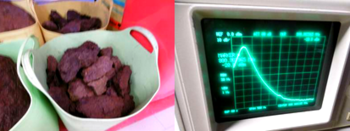FromDirtToSpace
| Project FromDirtToSpace | |
|---|---|

| |
| Creating Iron from dirt and get it into space | |
| Status | In progress |
| Contact | Gori, Ranzbak, Molenaar |
| Last Update | 2019-07-15 |
What?
Make our own iron from local materials, and get it into a space project.
Why?
Because we can, of course. Also, by redoing history, we learn a lot about how history progressed, and especially why.
Phase I - coonceptual design
Goals:
- Have fun !
- Proof of priciple application
- Producing functional wraught iron and forging it into a useful, everyday product
- using COTS non-specialist components and byproducts of industrial society - things that you could find in Fallout
- nice to have : if possible, as reusable as possible
- getting the reduction reaction going and under control
- Nice to have : measurements and "automated" control - airflow, temperature, material composition, pyrometer
- Experiencing and documenting the process
- Nice to have : locating and collecting our own local ore -> moerasoer / klappersteen / "knollen" / kwel : locaties
- telling a story of the hidden aspects of technology and the ease of "living" in 21st century
- Just how hard it is to make a simple, very crappy object
- Must have : as complete video/textual record as possible
- Lessons learned
- Responsible handling of waste products
- Is there something we can upcycle and sell to hipsters for lots of money to fund the project?
Preparations
- Furnace
- Select and specify design
- Identify and source charcoal and ore
- Identify and collect relevant tools
- People
- Who is involved, and at which tasks
- Find someone for documenting / filming
- SHE
- Identify any speciffic risks associated
- Personal protection measures
- Make a waste management plan
Phase II - Test
Approach
- KISS, but complete
- At hack42, a weekend long project
Execution
- Planned design (dead link, archived version)
- Ore acquired
Result
- Blog at hack42 with pictures.
- Hackaday article by Jenny List
We did get some crude iron, and some hands-on experience. The bloom welded itself to the blow pipe, so it had cooled down before we could manage to forge it. Preheating the furnace with wood pellets did not turn out to be a good idea, because the pellets did not burn down to ashes. There was a lot of heat near the airflow entrance, but too little heat on the opposite wall. A more distributed and more powerful air inflow would probably be a better option.
Second Run : Codename Fo'Realz
18-21 July 2019 at Hack42
Preparing the ore
-
Raw iron dirt
-
Clean bog ore
-
Reducing the ore in the kiln
-
Baked result
Phase III - ???
- Process control and yield maximization
- Show and dramatic infotainment
Some experiments with our bog ore
We have about 260 kilograms of bog iron ore at our disposal. The material is quite porous, so a significant percentage of that weight is just unbound water, and even light oven-baking at 150 degrees C for a few hours resulted in about 10% weight reduction. The material seems to be made up of harder silicate concretions in a matrix of loosely bound hydrated iron oxide. After baking, a few good whacks with a hammer is all that is needed to separate the rock into finely powdered ochre dust (interspersed with some fine silt/sand) and harder pebbles of what looks to be predominately silicate-based rock. The majority of the ore does seem to be made up of iron compounds, which is good news for us.
A rudimentary assay of the ore would be useful, so an attempt was made to convert all iron compounds to soluble form with nitric acid. The iron nitrate can then be separated from the unreactive silicates, and the oxidizing nature of HNO3 will handily also convert any Fe(ii,iii) compounds to Fe(iii). This approach hasn't worked so far though, probably because we haven't been able to get the material fine enough for the acid to react with the ore to completion. A ball mill is not yet a part of our toy collection at revspace, but more manual violence and grinding may yield success in a future attempt. Efforts to dissolve the rock thus far have at least offered a little more insight into the chemical composition of the ore. Most of the bulk does indeed seem to be hydrated iron (iii) oxide (goethite), and applying a magnet to the crushed material also reveals what appears to be a small amount of magnetite. Addition of crushed ore to concentrated acid results in some minor bubbling of what is most likely carbon dioxide, pointing to the presence of a small amount of carbonate.
As a side track to the iron smelting, we will also try to process some of the ore into various iron pigments. The plan is to dissolve the iron oxide in hydrochloric acid, filter off the solute, drop out the iron compound in the form of iron hydroxide and then kiln fire it to obtain relatively pure red iron (iii) oxide. We were also successful in reducing the iron (iii) by roasting the ore in the reducing flame of a blacksmith's furnace, opening up the possibility for making some black magnetite pigments.



